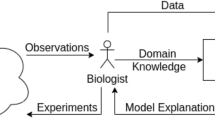Abstract
This collection of articles is the first of two parts of a special issue on “Neural Networks and Structured Knowledge.” The contributions to the first part shed some light on the issues of knowledge representation and reasoning with neural networks. Their scope ranges from formal models for mapping discrete structures like graphs or logical formulae onto different types of neural networks, to the construction of practical systems for various types of reasoning. In the second part to follow, the emphasis will be on the extraction of knowledge from neural networks, and on applications of neural networks and structured knowledge to practical tasks.
Similar content being viewed by others
References
C. Van Doren, “A history of knowledge,” Ballantine Books, 1991.
J.A. Feldman, “Connectionist models and parallelism in high level vision,” Computer Vision, Graphics, and Image Processing, vol. 31, pp. 178–200, 1985.
G. Hinton, “Connectionist learning procedures,” Technical Report CMU-CS–87–115, Carnegie-Mellon University, Pittsburgh, PA 15213, 1987.
D.E. Rumelhart, G.E. Hinton, and J.L. McClelland, “A general framework for parallel distributed processing,” Parallel Distributed Processing: Explorations in the Microstructure of Cognition, Bradford Books: Cambridge, MA, vol. 1, 1986.
J.A. Fodor and Z.W. Pylyshyn, Connectionism and cognitive architecture: A critical analysis, Elsevier Science Publishers B.V.: Holland, 1988.
P. Smolensky, “On the proper treatment of connectionism,” Behavioral and Brain Sciences, vol. 1, pp. 1–74, 1988.
R. Pfeifer, Z. Schreter, F.F. Soulie, and L. Steels (Eds.). Connectionism in Perspective, Amsterdam, 1989. Elsevier North Holland.
S. Addanki, “Connectionism,” in Encyclopaedia of Artificial Intelligence, edited by S.C. Shapiro, Wiley: New York, pp. 268–274, 1992.
F.J. Kurfeß (Ed.), “Neural Networks and Structured Knowledge,” European Conference on Articial Intelligence (ECAI '96) Workshop Proceedings, Budapest, 1996. European Coordinating Committee for Artificial Intelligence (ECCAI).
R. Sun and F. Alexandre (Eds.), Connectionist-Symbolic Integration, Lawrence Erlbaum, 1997.
L. Medsker, Hybrid Neural Network and Expert Systems, Kluwer: Boston, 1994.
S. Goonatilake and S. Khebbal. Intelligent Hybrid Systems, John Wiley & Sons, 1995.
F.J. Kurfeß. Special issue on “Neural Networks and Structured Knowledge: Rule Extraction and Applications” (guest editor). Applied Intelligence, vol. 11,no. 2, 1999.
J. Sinclair (Ed.), Collins Cobuild English Language Dictionary, Collins: London, Glasgow, 1987.
M.-Webster, Infopedia 2: The Ultimate Multimedia Encyclopedia and Reference Library, Softkey/Merriam-Webster, 1994. CD-ROM.
N.K. Kasabov, Foundations of Neural Networks, Fuzzy Systems, and Knowledge Engineering, MIT Press, 1996.
A. Newell, “The knowledge level,” Artificial Intelligence, vol. 18, pp. 87–127, 1982.
A.G. Hoffmann, Paradigms of Artificial Intelligence, Springer, 1998.
L. Shastri and J.A. Feldman, “Evidential reasoning in semantic networks: A formal theory,” IJCAI '85, pp. 465–474, 1985.
P. Hanks (Ed.), Collins Dictionary of the English Language, William Collins Sons & Co. Ltd: London, Glasgow, 1979.
H. Bosch and F.J. Kurfeß, “Incomplete interconnectivity in neural associative memories,” Neural Networks, vol. 11,No. 5, pp. 869–876, July 1998.
H.J. Bentz, M. Hagström, and G. Palm, “Information storage and effective data retrieval in sparse matrices,” Neural Networks, vol. 2,no. 4, pp. 289–294, 1989.
G. Palm, “Rules for synaptic changes and their relevance for the storage of information in the brain,” in Cybernetics and Systems Research, edited by R. Trappl, North Holland, 1982.
G. Palm, “On the information storage capacity of local learning rules,” Neural Computation, vol. 4,no. 5, pp. 703–711, 1992.
J.B. Pollack, “Recursive distributed representations,” Artificial Intelligence, vol. 46, pp. 77–105, 1990.
A. Sperduti, “Labeling RAAM,” Technical Report TR–93–029, International Computer Science Institute, Berkeley, CA, 1993.
T.A. Plate, “Distributed representations and nested compositional structure,” Ph.D. Thesis, Department of Computer Science, University of Toronto, 1994.
P. Kanerva, “Binary spatter-coding of ordered k-tuples,” in Artificial Neural Networks—ICANN Proceedings, edited by C. von der Malsburg, Vj. von Seelen, J.C. Vorbruggen, and B. Sendhoff, vol. 1112 of Lecture Notes in Computer Science, Springer: Berlin, pp. 869–873, 1996.
R.W. Gayler, “Holographic networks are hiking the foothills of analogy,” Neural Computing Surveys, vol. 2, 1999.
S. Hölldobler and Y. Kalinke, “Towards a new massively parallel computational model for logic programming,” in Combining Symbolic and Connectionist Processing, edited by M. Hilario, ECAI'94 Workshop W 14, Amsterdam, pp. 68–77, August 1
V. Ajjanagadde and L. Shastri, “Rules and variables in neural nets,” Neural Computation, vol. 8,no. 1, pp. 121–134, 1991.
L. Shastri and V Ajjanagadde, “From simple associations to systematic reasoning: A connectionist representation of rules, variables, and dynamic bindings using temporal synchrony,” Behavioral and Brain Sciences, vol. 16, pp. 417–494, 1993.
G. Paaß and F.J. Kurfeß (Eds.), Wissensverarbeitung mit neuronalen Netzen (Knowledge Processing with Neural Networks), number 221 in GMD-Studien, Schloß Birlinghoven, 53757 Sankt Augustin, Germany, September 1993. Gesellschaft für Mathematik und Datenverarbeitung (GMD). Workshop KI'93.
G. Paaß and F.J. Kurfeß, “Wissensverarbeitung mit neuronalen Netzen,” in Grundlagen und Anwendungen der Künstlichen Intelligenz-17. Fachtagung für Künstliche Intelligenz (KI'93), edited by O. Herzog, T. Christaller, and D. Schütt, Informatik aktuel, Subreihe Künstliche Intelligenz, Springer Verlag: Berlin, pp. 217–225, 1993.
F.J. Kurfeß and G. Paaß (Eds.), Integration Neuronaler und Wissensbasierter Ansätze, number 242 in GMD-Studien, D-53754 Sankt Augustin, Gesellschaft für Informatik (GI), Gesellschaft für Mathematik und Datenverar-beitung (GMD). Workshop at the KI'94 Conference, Saarbrücken, Germany, September, 1994.
I. Duwe, F.J. Kurfeß, G. Paaß, and S. Vogel (Eds.), Konnektionismus und neuronale Netze—Beiträge zur Herbstschule HeKoNN 94, number 242 in GMD-Studien, D-53754 Sankt Augustin, Oktober 1994.
F.J. Kurfeß, “Wissensverarbeitung mit neuronalen Netzen,” in G. Dorffner, K. Möller, G. Paaß, and S. Vogel (Eds.), Konnektionismus und neuronale Netze—Beiträge zur Herbstschule HeKoNN'95, GMD-Studien, D-53754 Sankt Augustin, pp. 211–223, Oktober 1995. Gesellschaft für Mathematik und Datenverarbeitung (GMD).
Author information
Authors and Affiliations
Rights and permissions
About this article
Cite this article
Kurfess, F.J. Neural Networks and Structured Knowledge: Knowledge Representation and Reasoning. Applied Intelligence 11, 5–13 (1999). https://doi.org/10.1023/A:1008327412259
Issue Date:
DOI: https://doi.org/10.1023/A:1008327412259




